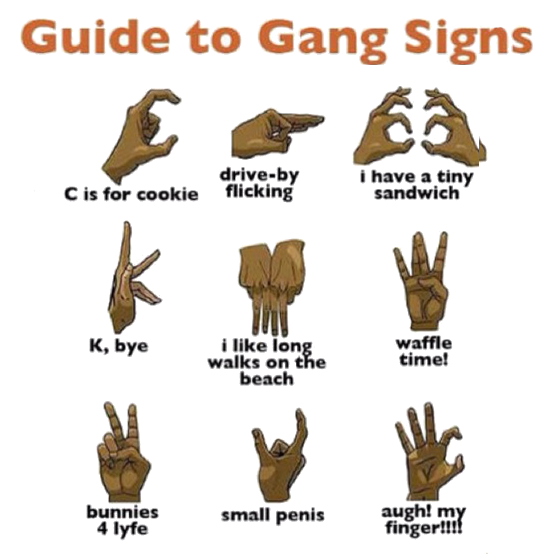Gang signs and meanings have been a part of urban culture for decades, often used to communicate within communities and assert territorial claims. These signs can be seen in various forms, from hand gestures to graffiti, and they play a significant role in the identity and culture of different gangs. While some may view these symbols as mere street art or expressions of rebellion, they hold deeper meanings that can signify allegiance, respect, and sometimes threats. In this article, we will explore the intricacies of gang signs and their meanings, shedding light on a phenomenon that is often misunderstood.
Understanding the gang signs and meanings requires a look into the socio-economic factors that contribute to gang formation and the languages they develop. These signs are not just random; they are deeply rooted in the history and experiences of the communities from which they originate. As society evolves, so do the signs, often influenced by popular culture and the media. This dynamic nature makes it essential to continuously study and analyze these symbols to grasp their current implications.
In this article, we aim to demystify the world of gang signs, exploring their origins, meanings, and the cultural significance they hold. By examining various gangs and their unique signs, we can gain insight into the social dynamics at play and the messages that these signs convey. Join us as we unravel the layers of meaning behind gang signs and discover what they reveal about the communities that use them.
What Are Gang Signs?
Gang signs are hand gestures or symbols used by gang members to communicate with one another and to assert their identity. These signs can vary greatly between different gangs and regions, serving as a way of expressing loyalty, marking territory, or indicating status within the gang. Understanding these signs requires knowledge of the specific gang culture and the context in which they are used.
Why Do Gangs Use Signs?
Gangs use signs for several reasons:
- Communication: Signs allow gang members to communicate discreetly, especially when in the presence of outsiders.
- Identity: They help establish a sense of belonging and identity among members.
- Intimidation: Displaying signs can serve as a warning to rivals and assert dominance in a territory.
- Tradition: Many signs are rooted in the history and traditions of the gang, passed down through generations.
What Are Some Common Gang Signs and Their Meanings?
Different gangs have their unique signs, but some common symbols include:
- The "Blood" Hand Sign: A gesture made by forming a "B" with the fingers, representing the Bloods gang.
- The "Crip" Hand Sign: A sign that forms a "C" with the fingers, associated with the Crips gang.
- Five Point Star: Often used by various gangs, representing the five points of a star which can signify many meanings, including protection and guidance.
- Crossed Fingers: Represents loyalty to the gang and can also indicate a specific gang affiliation.
How Do Gang Signs Evolve Over Time?
Gang signs are not static; they evolve and change with time. New signs may emerge as gangs adapt to changing social landscapes or as a response to rival gangs. Popular culture, media influence, and technology also play a significant role in the evolution of these signs. For example, the rise of social media has led to the rapid spread of new gang symbols and meanings, sometimes leading to misunderstandings or misinterpretations.
Can Gang Signs Impact Communities?
Yes, the presence of gang signs can significantly impact communities in various ways:
- Perception: The visibility of gang signs can shape how people perceive a neighborhood, often associating it with crime and violence.
- Safety: The display of gang signs can lead to increased tensions between rival gangs, potentially resulting in violence.
- Cultural Identity: For some, gang signs are a source of pride and cultural identity, representing resistance and community solidarity.
What Role Do Law Enforcement Agencies Play?
Law enforcement agencies often monitor gang signs to track gang activity and prevent violence. Understanding gang signs and meanings allows them to identify gang members, their affiliations, and potential conflicts. This knowledge can be crucial in developing strategies to address gang-related issues in communities.
Conclusion: Understanding the Importance of Gang Signs and Meanings
In conclusion, gang signs and meanings are complex symbols that reflect the cultural, social, and historical contexts of the communities they originate from. While they can be associated with negative connotations, it is essential to approach the subject with an understanding of the underlying factors that contribute to gang formation and the use of these signs. By educating ourselves about the meanings behind gang signs, we can foster a greater understanding of the challenges faced by these communities and work towards solutions that promote safety and unity.
You Might Also Like
Aubree Skye Lind-DeBoer: A Rising Star In The SpotlightIs Andrew Really Cake? The Delicious Mystery Unraveled
Unraveling The Emotions Behind A Tear In My Beer
Exploring The Meaning Of Ohana: A Journey Into Family And Togetherness
Understanding The Conversion Of 25 Kilos In Pounds
Article Recommendations
- Sir Carter
- Julia Louis Dreyfus Saturday Night Live
- Tia Hernlen Today Instagram
- Rachel Chandler
- Darko Stosic Net Worth
- You Have One Month Left To Buy A House According To
- Who Is Tulsi Gabbards Ex Husband
- Jade Castrinis
- Donnie Van Zant
- Jessica Samko Instagram


